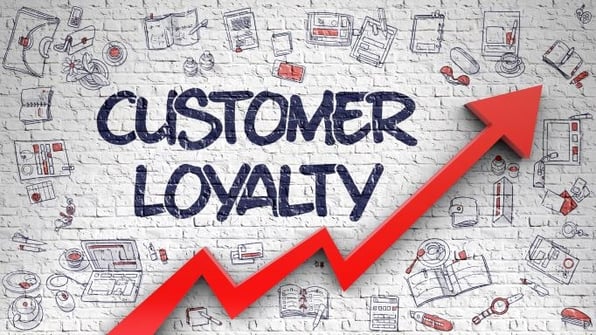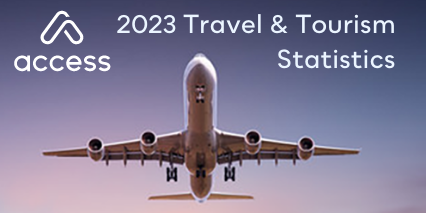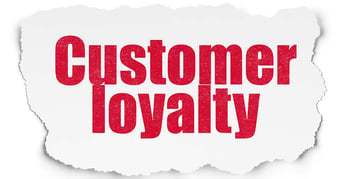2022 Customer Engagement & Loyalty Statistics
This page, however, is for the raw data. For your convenience, we've compiled dozens of loyalty statistics published in 2022 - from how many people are active in loyalty programs to what they're looking to get out of them and how they'd like to be communicated with.
- 2022 Customer Engagement & Loyalty Statistics
- 2022 Loyalty Program / Loyalty Marketing Statistics
- 2022 Retail Loyalty Statistics
- 2022 Mobile/Online Marketing Statistics
- 2022 Restaurant Loyalty Statistics
- 2022 B2B Loyalty Statistics
- 2022 Membership Engagement Statistics
- 2022 Other Loyalty Statistics
2022 Customer Engagement & Loyalty Stats
- 38.5% of global shoppers believe they have to buy from a certain brand multiple times before they consider themselves “loyal” (Yopto)
- When asked what it means to be loyal to a brand, global shoppers answered: (Yopto)
- Buying from the same brand repeatedly (82.2%)
- Pride in being associated with the brand (43.3%)
- Buying from the brand despite cheaper competitors (42%)
- Recommending the brand to others (47%)
- 86% of customers are willing to pay more for a great customer experience (Mad Mobile)
- 44% of consumers will continue to shop at brands that don’t share their values, 60% are unaware of where their favorite brands fall on the political spectrum and 75% believe brands have as much right to free speech as individuals (Clarus Commerce)
- 69% of consumers say their favorite brand is part of who they are, with 24% of them strongly feeling the brand impacts their identity (Clarus Commerce)
- 56% of consumers still shop with brands that have contrary beliefs in order to get a better deal (Clarus Commerce)
- 76% of people report their loyalty to a brand is impacted by the opinions of friends and family, while paid celebrities/influencer endorsements only impact 44%, and media coverage impacts 57% (Clarus Commerce)
- Only 16% of consumers say a brand’s values are the main reason they stay loyal, and the same would abandon a brand if it didn’t live up to its pledges (Clarus Commerce)
- Customers are loyal to their favorite brands for the following reasons: (Clarus Commerce)
- Higher quality product (27%)
- Strong sense of community (22%)
- Better prices (17%)
- Knows me and my preferences (11%)
- Customers who consider community to be an important value believe these activities to be the most important for fostering a sense of community: (Clarus Commerce)
- Joining online groups (34%)
- Attending in-person events (32%)
- Consuming brand related content (18%)
- Receiving exclusive products or offers (15%)
- Customers are most likely to lose loyalty with their favorite brands and try a different brand instead when: (Clarus Commerce)
- The brand’s product quality declines (65%)
- The brand’s prices increase (47%)
- The brand takes a stance on a social issue they disagree with (33%)
- Delivery becomes slow or unreliable (23%)
- I hear the brand isn’t living up to its publicly stated values (16%)
- My friends/family stop talking about or posting about the brand (15%)
- The brand stops hosting in-person events (6%)
- When thinking about their favorite brands, Gen Z is most likely to report they are loyal because “this brand does good in the world or has a positive social impact” (28%), millennials are loyal because “I feel a strong sense of community with other loyalty to this brand (28%) and other generations are loyal because “this brand offers a higher quality product than similar brands: Gen X (30%), Baby boomers (47%) and those over 74 (41%) (Clarus Commerce)
- 58% of consumers have rarely or never shared a post about their favorite brand on social media (Clarus Commerce)
- 16% of consumers have participated in a boycott of a brand they regularly bought from, 14% have destroyed or thrown something from the brand away and 11% have posted something negative about the brand on social media (Clarus Commerce)
- 67% of consumers buy from their favorite brands at least once a month (Clarus Commerce)
- 48% of consumers have told friends about their favorite brands in the last 12 months (Clarus Commerce)
- 24% of consumers provide feedback and fill out surveys from their favorite brands (Clarus Commerce)
- 19% of consumers share personal data with their favorite brands (Clarus Commerce)
- 63% of consumers believe that liking or buying a brand can be a political statement (Clarus Commerce)
- 75% of consumers believe brands are cancelled too quickly, and 79% say brands can be unfairly targeted for political reasons (Clarus Commerce)
- 62% of consumers believe that throwing away or destroying a product is a bad way to show disapproval of a brand (Clarus Commerce)
- Consumers are willing to share the following personal information with their favorite brands in exchange for a better customer experience or discount: Email (73%), Name (65%), Birthday (56%), Phone number (38%), Demographic data like race, income and age (34%), Home address (31%), Social media handle (21%), Health and well-being data like heart rate and sleep times (12%), Biometric data like fingerprints and eye scans (8%), Social security number (8%) and Web browsing history (7%) (Clarus Commerce)
- On average, younger consumers are far more likely to be aware of the values and social stances of brands: 72% of Gen Z, 58% of millennials, 49% of Gen X, 32% of baby boomers and 28% of those over 74 (Clarus Commerce)
- In March 2022, 60% of US consumers believed brands should stop doing business in Russia (Gartner)
- When already loyal to a brand, U.S. shoppers are willing to: (Yopto)
- Sign up for a loyalty program (73.3%)
- Wait until an out-of-stock item is back in stock (66%)
- Sign up for emails (63.1%)
- Sign up for text (41.5%)
- Pay more to buy with brand despite cheaper competitors (53.5%)
- Recommend it to others (58.8%)
2022 Loyalty Program / Loyalty Marketing Stats
- 86% of U.S. shoppers said that a loyalty program influences them to buy again from a brand (Yopto)
- 44% of U.S. shoppers said that a loyalty program highly influences their purchase decision (Yopto)
- 76% of U.S. shoppers are most likely to participate in a food & beverage brand’s loyalty program, 66.2% in fashion & apparel, 55.4% in beauty & cosmetics, 55.1% in consumer electronics and 31% in home electronics (Yopto)
- Loyalty programs make 60% of global shoppers more loyal to a brand (Yopto)
- 65% of global shoppers would sign up for a loyalty program with a brand to which they are already loyal (Yopto)
- When they are already loyal to a brand, global shoppers are willing to: (Yopto)
- Sign up for their loyalty program (65.3%)
- Wait to purchase out of stock items until they are back in stock (59%)
- Sign up for emails (58.5%)
- Recommend to others (54.5%)
- Sign up for texts (23.1%)
- 83% of global shoppers said belonging to a loyalty program influences their decision to buy again from a brand (Yopto)
- 64% of consumers check their loyalty status or points at least once a month, and 36% check weekly (Clarus Commerce)
- 32% of consumers have participated in their favorite brand’s loyalty program in the last 12 months (Clarus Commerce)
- The coupon industry is projected to grow 56.5% by 2025 (Adjust)
- 54% of organizations will prioritize shifting from reactive to proactive service in 2022 (Gartner)
- 82% of organization have or plan to have a “value enhancement strategy” to help promote business growth (Gartner)
- 74% of organizations say creating a seamless customer journey across assisted and self-service channels is “important” or “very important” (Gartner)
- 53% of organizations don’t believe they make it easy for customers to handle their issues/requests (Gartner)
- By 2025, 75% of brands are predicted to “break up” with poor-fit customers (Gartner)
- Only 14% of organizations have achieved a 360 degree view of their customers, and 82% said they aspire to attain this goal (Gartner)
- 80% of customers are demanding quicker responses from businesses in 2022 (Fresh Works)
- 39% of consumers prefer self-service customer service options because they feel that is the quickest route to a solution (Fresh Works)
- 61% of consumers admire companies that us a mix of self-service and human customer service options (Fresh Works)
- 39% of customers expect agents to know who they are and the context of their query immediately (Fresh Works)
- 59.8% of global shoppers want to engage with a brand’s loyalty program via mobile devices while shopping online, and 48.7% via mobile device while shopping in-store (Yopto)
- 25.2% of shoppers say their biggest frustration with loyalty programs is the disconnect between the retailer’s online and offline presences (Yopto)
- When engaging with a loyalty program in-store, 70.1% of shoppers prefer to engage via mobile device rather than through a store associate (23.7) (Yopto)
- 73.3% of U.S. shoppers would sign up for the loyalty program of a brand to which they are already loyal (Yopto)
2022 Mobile / Online Marketing Stats
- 86% of businesses use video as a marketing tool (Wyzowl)
- 64% of businesses say their video marketing plans for 2021 and 2022 have been affected by the pandemic. 3 out of 4 of these said the pandemic will made it more likely they would create video (Wyzowl)
- 74% of video content created by businesses are explainer videos, 46% are video testimonials, 42% are video ads, 29% are for onboarding customers, 20% are customer service videos (Wyzowl)
- 62% of businesses say video marketing success is determined by the engagement their videos get including shares, likes and comments (Wyzowl)
- 44% of businesses say brand awareness and PR are their criteria for video success (Wyzowl)
- 41% of businesses say customer engagement and retention are their primary measuring sticks for video marketing success (Wyzowl)
- 27% say bottom-line sales are their yardstick for determining whether a video is successful or not (Wyzowl)
- 87% of businesses say video marketing has helped them increase website traffic and 82% say it helped them increase the amount of time people dwell on their websites (Wyzowl)
- 93% of businesses say marketing videos have helped them increase brand awareness, and 87% report a good ROI (Wyzowl)
- 96% of people have watched an explainer video to learn more about a product or service (Wyzowl)
- 88% of people say they’ve been convinced to buy a product or service by watching a brand’s video, 78% to buy or download a piece of software or app (Wyzowl)
- When asked how they’d most like to learn about a product or service, 73% of customers said they’d prefer to watch a short video, 11% prefer to watch a short video, 4% prefer infographics (Wyzowl)
- People are twice as likely to share video content with their friends than any other type of content, including social media posts, blog articles, product pages, etc. (Wyzowl)
- 99% of people who use video for marketing will continue to use video in 2022, and 66% of those will increase or maintain their spend (Wyzowl)
- 1 in 3 leaders believe that building new generation digital platforms to help customer-facing teams work better is a top digital investment priority (Fresh Works)
- 1 in 3 decision-makers implementing AI believe that optimizing AI to predict customer needs and deliver personalized experiences is a key consideration for driving ROI (Fresh Works)
- 67% of all eCommerce sales occur through mobile devices (Mad Mobile)
- 69% of consumers want store associates to have mobile devices so they can look up product information and check inventory for them on the spot (Mad Mobile)
- Companies that prioritized omnichannel customer engagement saw 9.5% year over year average growth, compared to 3.4% for companies that did not (Mad Mobile)
- Nearly 80% of users prefer omnichannel strategies because of the seamless communication experience
- 82% of customers expect contactless experiences in the future (Mad Mobile)
- In 2022, there are expected to be 100 million social commerce buyers, up from 80 million last year (Mad Mobile)
- 58% of in-store shoppers say it’s faster to look product information on their phones than to ask an associate. 64% of associates agree with this statement (Mad Mobile)
- By 2022, it’s predicted online sales in the U.S. will surpass $1 trillion, a 17% increase over 2021 at $933 billion (Mad Mobile)
- In 2021, nearly 36% of shoppers mad a purchase through social media, resulting in $36 billion in sales which is a 35% growth over 2020 and it’s expected to grow in 2022 (Mad Mobile)
- 22% of shoppers made at least one purchase through Facebook (Mad Mobile)
- 75% of shoppers have used BOPIS (buy online, pickup in store) or curbside pickup (Mad Mobile)
- The number of people using digital wallets apps is about 101 million, and that could grow by an additional 6.5 million a year through 2025 (Mad Mobile)
2022 Retail Loyalty Statistics
- 31% of Americans are spending as of April 2022 than before the pandemic, 23% said they’re spending less and 41% said they’re spending about the same (Morning Consult)
- 47% of consumers said they’re spending more online as of April 2022 than they were before the pandemic and 9% said they’re spending less online (Morning Consult)
- 78% of US adults said they are comfortable going to a department store as of April 2022, 77% to a local store or boutique and 71% to a shopping mall (Morning Consult)
- 13% of all US adults are spending much more as of April 2022 than they did since the COVID-19 pandemic started (Morning Consult)
- 2022 is expected to see a 160% increase in the frequency of digital purchases (Fresh Works)
- 67.4% of shoppers want to shop directly from brands to which they are loyal, rather than shopping on Amazon (44.6%) or another third party retailer (37%) (Yopto)
- Besides shopping on the brand’s website or in its stores (the preferred method of 67.4%) loyal shoppers will also shop directly from an email sent from the brand (25.1%), shop directly from the brand’s Instagram post (12.3%), shop directly from a text sent from the brand (9.8%) and shop directly from a TikTok ad (5%) (Yopto)
- 80% of buyers are more likely to make a purchase when brands offer personalized experiences (Fresh Works)
- Over 45% of US shoppers say they seldom or never typically find the perfect size, shape or fit (PSFK)
- 57% of US shoppers say they would only share a little or moderate amount of data to brands and retailers in order to be offered products that are the right size & shape, and 14% don’t want to share any data at all (PSFK)
- 48% of US shoppers would prefer to buy from companies that make their products within 100 miles of where they live. On the other hand, 31% of U.S. shoppers are happy to have their goods made anywhere in North America, 15% anywhere in the world (PSFK)
- 43% of US shoppers are concerned or very concerned about the environmental impact made by the shipping and deliveries of their online shopping, while only 7% say they are not concerned at all (PSFK)
- 65% of all shoppers use resale and recommerce services (Retail Touchpoints)
- 30% of major retail brands are involved with resale services (Retail Touchpoints)
2022 Restaurant Loyalty Statistics
- 75% of people report they feel comfortable going to a restaurant or café as of April 2022 (Morning Consult)
- 81% of people feel comfortable eating outdoors at a restaurant or café as of April 2022, compared to 73% who feel comfortable eating inside (Morning Consult)
- Millennials are four times more likely than baby boomers to order takeout or food delivery a few times a week or more (Morning Consult)
- 53% of US adults order takeout or food delivery a few times a month or more frequently (Morning Consult)
- 46% of adults with children in the household order takeout or food delivery at least once a week, compared to 25% of adults with no children in the household (Morning Consult)
- 29% of US adults feel very comfortable going out to eat at a restaurant right now, and 33% feel somewhat comfortable (Morning Consult)
- Dining frequency has not rebounded to 2019 levels: In April 2022, nearly 50% of adults eat out once a week, compared to 60% who did so in 2019 (Morning Consult)
- Takeout order levels stayed consistent throughout 2021 and into 2022, with an approximate average of 40% of adults ordering at least once a week (Morning Consult)

2022 Membership Loyalty & Engagement Stats
- 30% of membership executives reported they have a formal plan to measure their engagement efforts (ASI)
- 38% of associations report an increase in membership growth in 2021, as compared to only 26% in 2020 (MGI)
- 84% is the median membership renewal rate in 2021 (MGI)
- Baby Boomers are the largest single membership generation, accounting for 36% of the average membership group. GenXers account for 30%, and Millennials 21% (MGI)
- In 2021, only 10% of association executives rate their organization’s value proposition as “very compelling,” while 47% rate it as “somewhat,” “not very” or “not at all compelling.” (MGI)
- 47% of associations with a less than compelling value proposition are more likely to show a decline in their membership counts. (MGI)
- 40% of associations say the biggest challenge to growing membership is “communicating the value of their benefits.” (Up from 36% in 2020)
- As organizational innovation is directly correlated to driving membership growth, only 25% of association executives believe their organization is either “extremely” or “very” innovative. These organizations likewise report increases in new members and retention. (MGI)
- Only 26% of associations report having a specified process to support and grow innovation. (up from 20% in 2020). (MGI)
- 22% of associations report their organization dues structure has everyone pay the same dues amount. Only 16% of associations use a tiered membership model. (MGI)
- 30% of associations raised their dues in 2021.
- 22% of associations report they increase their dues annually. 53% reporting increasing dues “as needed.” Associations with member renewal rates at or above 80% are significantly more likely to have raise dues in 2021. (MGI)
- 43% of associations raised dues last year, citing “keeping up with inflation,” as their primary reason. 25% cited “supporting new programs/member benefits.” (MGI)
- 56% of associations that raised dues did not offer anything special to lessen the impact of the dues increase. 18% offered the old dues rate if renewals were completed early. (MGI)
- Only 4% of associations report a decline in membership after increasing their dues. (MGI) 63% report their membership either increased or remained the same.
- The most popular paid digital marketing tool among membership organizations is Facebook (40%). Ad retargeting (e.g. AdRoll) was second with 32%. 27% of associations use content marketing (blogs, videos, whitepapers, etc.). (MGI)
2022 Travel Stats
Our Travel Statistics have a new home! You can find all the latest and greatest here: 2022 Travel and Tourism Statistics and find years worth of travel data here: Travel and Tourism Statistics: The Ultimate Collection
Here's a sampling of the most recent statistics regarding travel loyalty and demand:
- Often a travel business’ loyalty program is worth more than the brand itself. For example, AAdvantage, American Airlines’ passenger loyalty program is valued between $19.5 - $31.5 billion compared to American Airlines which is valued at $6 billion (Catalyst)
- 80% of travel and hospitality marketers say their organization has a loyalty program (Catalyst)
- The average tenure of travel and hospitality loyalty programs is 6.5 years (Catalyst)
- 1/3 of travel and hospitality loyalty programs have undergone a recent refresh (Catalyst)
- 2/3 of travel and hospitality marketers feel they use loyalty best practices in running their programs (Catalyst)
- 77% of travel and hospitality loyalty programs offer transactional rewards, such as the ability to earn and redeem points (Catalyst)
- 69% of travel and hospitality loyalty programs offer member-only discounts (Catalyst)
- 61% of travel and hospitality loyalty programs offer rewards focused on access and personalization, like priority or exclusive access to the best rooms, seats or amenities (Catalyst)
- 59% of travel and hospitality loyalty programs offer personalized gift recognizing significant dates, like the member’s birthday (Catalyst)
- 1/3 of travel and hospitality brands that aren’t leading the industry in loyalty have no loyalty program at all, though 21% of those brands say they will have one in the future (Catalyst)
- 2/3 of the travel and hospitality industry’s leading loyalty programs use personalization methods, while only 48% of the industry’s non-leading loyalty programs do (Catalyst)
- US airlines are projecting 150% as many passengers to fly in 2022 as did in 2021 (IATA)
- 3.4 billion passengers are projected to fly in 2022, up from 2.3 billion in 2021, but still down from 4.5 billion in 2019 (IATA)
- In 2022 overall demand for flights is expected to reach 61% of pre-crisis (2019) levels. Capacity is expected to continue to increase faster than demand, reaching 67% of pre-crisis levels for 2022 (IATA)
- In 2022, demand for domestic flights is expected to reach 93% of pre-crisis (2019) levels (IATA)
- In 2022, demand for international flights is expected to reach 44% of pre-crisis (2019) levels (IATA)
- Air travel in January 2022 (measured in RPKs) was up 82.3% compared to January 2021, but down 4.9% compared to the previous month (December 2021) (IATA)
- January 2022 domestic air travel was up 41.3% compared to January 2021, but down 7.2% compared to December 2021 (IATA)
- January international air travel was up 165.6% compared to January 2021, but down 2.2% compared to December 2021 (IATA)
- Hotel demand in January 2022 was 9% below 2019 levels (US Travel)
- Overseas arrivals fell to 65% below 2019 levels in January 2022 (US Travel)
- 58% of tourism professionals predict a travel rebound in 2022 (mostly in the third quarter) and 42% predict the rebound won’t happen until 2023 (UNWTO)
- 64% of tourism experts predict international arrivals will return to pre-pandemic levels in 2024 or later (UNWTO)
- 2020 was the worst year on record for tourism and 2021 the second worst year on record (UNWTO)
- US adults say travel brands should definitely take these precautions: (Morning Consult)
- clean/sanitize common areas (71%)
- clean/sanitize private customer areas (70%)
- publicly share info about COVID-19 protocols (55%)
- allow for physical distancing (49%)
- require employees to wear masks (48%)
- require customers to wear masks (41%)
- use tech to minimize interactions (39%)
- 78% of US travelers intend to travel during 2022 (Trip Advisor)
- By the end of 2021, 78% of Americans were ready to travel (US Travel)
- By the end of 2021, 81% of global business travelers believed their 2022 domestic business travel volume could meet or exceed their pre-pandemic volume (US Travel)
2022 Other Loyalty Stats
- 81.9% of shoppers say it’s important that brands are transparent about using personal data (53.5% say it’s very important) (Yopto)
- 68% of shoppers are willing to share personal data in exchange for loyalty rewards (like tailored discounts) and/or personalized loyalty experiences. Specifically, they’re willing to share: (Yopto)
- Email (81.6%)
- Birthday (70.1%)
- Product preferences (55.6%)
- Phone number (39.5%)
- Fewer than 4% of shoppers worldwide are unwilling to share any type of personal data (Yopto)
- 60% of Americans are comfortable going to movie theaters as of April 2022, which is 16 points higher than the beginning of the year (Morning Consult)
- 66% of Americans are comfortable going to museums as of April 2022, 57% are comfortable visiting amusement parks and 48% are comfortable going to a concert (Morning Consult)
- 70% of republicans feel comfortable going to a movie theater as of April 2022 compared to 56% of democrats (Morning Consult)
- 50% of US adults are comfortable attending a sporting event as of April 2022 (Morning Consult)
- 2 out of 3 US adults who regularly attended sporting events before the pandemic are comfortable returning to events as of April 2022 (Morning Consult)
- 69% of US adults believe funding for climate change should come from the corporations themselves compared to 49% who believe it should come from prices on consumer goods (Morning Consult)
- 67% of shoppers believe grocery stores need to improve their sustainability credentials. In comparison, only 6% believe grocery stores do all they can to be environmentally friendly (AFN)
- 77% of shoppers have tried to make their purchase consumption habits more sustainable in the last year, and among 25 to 34-year-olds, it is 88% (AFN)
- 55% of shoppers would be more loyal to a brand if they perceived it to be more “green” (AFN)
- Nearly half of shoppers would happily pay a premium for good that were more “green” (AFN)
- 37% of U.S. consumers say they’re more likely to purchase a package food item if it includes a sustainability claim in 2022, up six points from 2019 (Cargill)
- 100% of retail executives say they expect supply chain disruptions to continue in 2022 (Retail Customer Experience)
- 94.1% of U.S. Gen Z shoppers are more inclined to be loyal to a brand with values that align with their own (Yopto)
- Business practices that discourage loyalty include: (Yopto)
- Supply chain loyalties with factories that mistreat employees (48% of global shoppers)
- Affiliation with a big polluter (22% of global shoppers)
- 82.7% of U.S. shoppers are concerned with how brands are using their data and to what end, however 72% were willing to share their data with their favorite brands (Yopto)
- The average median dues increase across associations is 5% (Marketing General)
- When associations raise dues 10% or more, they may see a slight decline in renewal rates (Marketing General)
- Among associations that recently raised dues, 27.5% maintained and 23.5% increased renewal rates when claiming that the increased rates supported new programs or member benefits (Marketing General)
- 27% of associations have returned to pre-pandemic messaging (Marketing General Inc)
- Use of market research and data analytics continue to increase since the pandemic, with 54% of associations implementing strategies to better understand members in the marketplace (Marketing General Inc)
- Associations communicate the following messaging to members: (Marketing General Inc)
- Emphasizing the benefits of membership (68%)
- Sharing crucial information (61%)
- Empathizing with members (53%)
- Providing financial support (21%)
- 85% of associations expect to see an increase in member engagement in 2022 (Marketing General Inc)
- 44% of associations expect to increase their membership marketing budgets in 2022 (Marketing General Inc)
- Only 8% of associations anticipate hosting a virtual-only event in 2022, as 84% saw a return to in-person meetings and events in 2021 (Marketing General Inc)
- 58% of associations say that everyone or most employees will continue to work remotely (Marketing General Inc)
- Moving into 2022, associations plan on exploring the following opportunities to better serve members: (Marketing General Inc)
- Increasing virtual professional development opportunities (83%)
- Develop new products and services (67%)
- Conduct market research/data analytics (54%)
Got Members/Customers of Your Own?
We at Access Development have spent literal decades finetuning the art of member engagement through membership perks, member benefits, discount programs for associations and the like. Contact us to learn more about the largest private discount program in the nation. Whether it's B1G1 deals at local restaurants, deep discounts on travel bookings or mobile coupons good at thousands of in-store retail locations, Access has the platform you need to add universal, everyday value to any membership.

Topics: millennial statistics, customer loyalty, statistics, loyalty statistics

Written by: Kendra Lusty














Share your Comment.